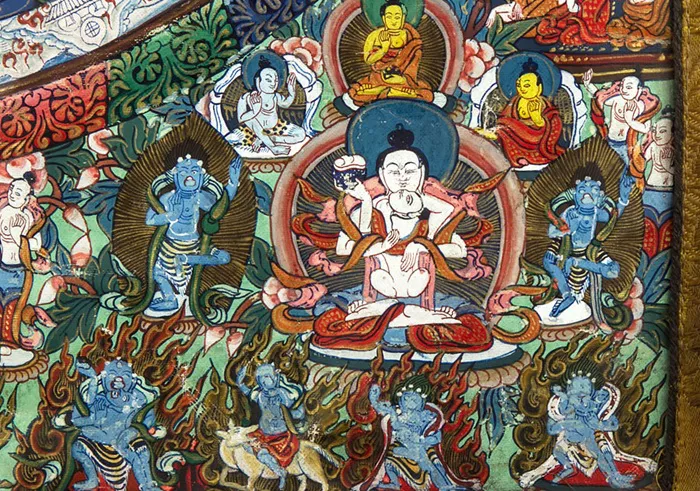A Thangkha is a traditional Tibetan Buddhist painting or textile. It usually shows a deity, a mandala, or an important Buddhist scene. Thangkhams are used as teaching tools and objects of meditation. They help Buddhists focus their minds and learn about Buddhist teachings.
Thangkhams are not just ordinary paintings. They are considered sacred and are treated with great respect. Each detail in a Thangkha has a meaning and follows strict rules. The colors, shapes, and symbols all have spiritual significance.
Origin and History of Thangkha
The word “Thangkha” means “something that is rolled up.” This is because these paintings are usually made on cloth and can be rolled like a scroll for easy transport. The tradition of creating Thangkhams started in Tibet more than a thousand years ago. It was influenced by Indian and Nepalese Buddhist art.
Monks and artists created Thangkhams to help spread Buddhism. These sacred images were carried by traveling teachers and used in temples and homes. Over time, Thangkha painting became a respected art form with special techniques passed down through generations.
The Meaning of Thangkha
Thangkhams are more than beautiful artworks. They are spiritual tools. Each Thangkha tells a story or represents a spiritual idea. They can show Buddha, bodhisattvas, protectors, or scenes from Buddhist texts. These images remind practitioners of the qualities to develop, such as compassion, wisdom, and patience.
Many people use Thangkhams in meditation. Looking at the image helps calm the mind and deepen concentration. Some Thangkhams are used to teach the life story of the Buddha or explain complex Buddhist philosophy.
Types of Thangkha
1. Buddha Images
The most common type of Thangkha shows the Buddha. Different Buddhas represent different qualities and teachings. For example, Shakyamuni Buddha is the historical Buddha who taught the Dharma. Medicine Buddha represents healing, and Amitabha Buddha is connected with compassion and the Pure Land.
2. Bodhisattvas
Bodhisattvas are enlightened beings who choose to help others before entering full Nirvana. Popular bodhisattvas like Avalokiteshvara, Manjushri, and Tara appear often in Thangkhams. Each bodhisattva has unique symbols and colors to show their special qualities.
3. Mandalas
Mandalas are geometric designs used for meditation and rituals. They represent the universe and the path to enlightenment. Thangkhams with mandalas are often very detailed and colorful. They help practitioners focus during complex meditation practices.
4. Protector Deities
Protector deities guard the teachings of Buddhism and its followers. They often look fierce and powerful in Thangkhams. These images remind practitioners that spiritual practice also needs strength and protection.
5. Life Scenes and Stories
Some Thangkhams show stories from the life of the Buddha or important Buddhist events. These help people understand Buddhist history and teachings in a visual way.
The Process of Creating a Thangkha
Making a Thangkha is a careful and spiritual task. Artists usually study Buddhist teachings deeply before starting. The process follows these main steps:
Preparing the Canvas
The canvas is made from cotton or silk. It is stretched on a frame and coated with a mixture of chalk and glue. This creates a smooth surface for painting.
Drawing the Outline
The artist draws the main design with precise measurements. This step is very important to keep the correct proportions, which must follow ancient rules.
Painting
Natural pigments and minerals are used to paint the Thangkha. These colors are mixed with water and animal glue. Each color has symbolic meaning and is carefully applied in layers.
Adding Details
Fine lines, gold leaf, and other decorations are added last. These details bring the Thangkha to life and give it spiritual power.
Cultural Significance of Thangkha
Thangkhams are central to Tibetan Buddhist culture. They serve many important roles:
Religious Use
Thangkhams are used in monasteries and homes for prayer and meditation. They help Buddhists connect with enlightened beings and the Dharma. During festivals and ceremonies, Thangkhams are displayed to bless the community.
Teaching Tools
Because most people in traditional Tibet could not read, Thangkhams were visual aids for teaching Buddhist ideas. Monks used them to explain stories, philosophy, and practice.
Artistic Heritage
Thangkha painting is a respected art form. Many families and monasteries pass down this skill. It keeps alive ancient traditions and preserves Buddhist culture.
Spiritual Protection
Many believe Thangkhams provide spiritual protection. Hanging a Thangkha at home or carrying a small one can bring peace and guard against negative influences.
How to Respect and Care for a Thangkha
Because Thangkhams are sacred, they must be treated with respect. Here are some important points:
- Always handle a Thangkha with clean hands.
- Do not place a Thangkha on the floor or in dirty places.
- If not used, store it rolled up and protected from moisture and sunlight.
- When displaying, place it higher than eye level as a sign of respect.
- Avoid touching the painted surface directly.
Modern Use of Thangkha
Today, Thangkhams are still important in Tibetan Buddhist communities worldwide. They have also attracted interest from people around the world for their beauty and spiritual meaning. Some artists blend traditional techniques with modern styles, but the sacred purpose remains the same.
Conclusion
A Thangkha is much more than a painting. It is a sacred object filled with Buddhist teachings and symbolism. Whether used for meditation, education, or decoration, Thangkhams connect people to the wisdom and compassion of Buddhism. Understanding their meaning and respecting their cultural value helps keep this ancient tradition alive.

